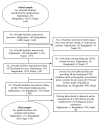Health Facilities Readiness and Determinants to Manage Cardiovascular Disease in Afghanistan, Bangladesh, and Nepal: Evidence from the National Service Provision Assessment Survey
- PMID: 38524910
- PMCID: PMC10959132
- DOI: 10.5334/gh.1311
Health Facilities Readiness and Determinants to Manage Cardiovascular Disease in Afghanistan, Bangladesh, and Nepal: Evidence from the National Service Provision Assessment Survey
Abstract
Background: In South Asia, cardiovascular diseases (CVDs) are an increasing public health concern. One strategy for dealing with the growing CVDs epidemic is to make health facilities more ready to provide CVDs services. The study's objectives were to: (1) assess healthcare facilities' readiness to offer CVDs services; and (2) identify the variables that influence such readiness.
Methods: This study employed data from the Afghanistan Service Provision Assessment Survey 2018-2019, Bangladesh Health Facility Survey 2017, and Nepal Health Facility Survey 2021 that were cross-sectional and nationally representative. In Afghanistan, Bangladesh, and Nepal, 117, 368, and 1,381 health facilities, respectively, were examined. A total of 10 items/indicators were used to measure a health facility's readiness to provide CVDs services across three domains.
Results: The mean readiness scores of managing CVDs were 6.7, 5.6, and 4.6 in Afghanistan, Bangladesh, and Nepal, respectively. Availability of trained staff for CVD services are not commonly accessible in Afghanistan (21.5%), Bangladesh (15.3%), or Nepal (12.9%), except from supplies and equipment. Afghanistan has the highest levels of medicine and other commodity availability. Among the common factors linked with readiness scores, we ought to expect a 0.02 unit rise in readiness scores for three nations for every unit increase in number of CVDs care providers. In Afghanistan, Bangladesh, and Nepal, availability of both diagnosis and treatment facilities was associated with increases in readiness scores of 27%, 9%, and 17%, respectively. Additionally, an association was observed between nation-specific facility types and the readiness scores.
Conclusions: Country-specific factors as well as universal factors present in all three nations must be addressed to improve a health facility's readiness to provide CVDs care. To create focused and efficient country-specific plans to raise the standard of CVD care in South Asia, more investigation is necessary to ascertain the reasons behind country-level variations in the availability of tracer items.
Keywords: South Asia; cardiovascular diseases; health facilities readiness; health services; service provision assessment survey.
Copyright: © 2024 The Author(s).
Conflict of interest statement
The authors have no competing interests to declare.
Figures
Similar articles
-
Assessing the readiness of health facilities to provide family planning services in low-resource settings: Insights from nationally representative service provision assessment surveys in 10 Countries.PLoS One. 2023 Nov 16;18(11):e0290094. doi: 10.1371/journal.pone.0290094. eCollection 2023. PLoS One. 2023. PMID: 37972005 Free PMC article.
-
Health system's readiness to provide cardiovascular, diabetes and chronic respiratory disease related services in Nepal: analysis using 2015 health facility survey.BMC Public Health. 2020 Jul 25;20(1):1163. doi: 10.1186/s12889-020-09279-z. BMC Public Health. 2020. PMID: 32711487 Free PMC article.
-
Readiness of health facilities to provide services related to non-communicable diseases in Nepal: evidence from nationally representative Nepal Health Facility Survey 2021.BMJ Open. 2023 Jul 9;13(7):e072673. doi: 10.1136/bmjopen-2023-072673. BMJ Open. 2023. PMID: 37423630 Free PMC article.
-
Health System Capacity and Access Barriers to Diagnosis and Treatment of CVD and Diabetes in Nepal.Glob Heart. 2021 May 18;16(1):38. doi: 10.5334/gh.927. Glob Heart. 2021. PMID: 34040951 Free PMC article.
-
The availability and distribution of health services and resources across different regions in Afghanistan.Front Public Health. 2025 Jan 24;12:1371104. doi: 10.3389/fpubh.2024.1371104. eCollection 2024. Front Public Health. 2025. PMID: 39926293 Free PMC article. Review.
Cited by
-
Implications of the dissemination of healthy lifestyle advice for Afghan adults without histories of hypertension diagnosis or treatment.J Rural Med. 2025 Apr;20(2):102-111. doi: 10.2185/jrm.2024-046. Epub 2025 Apr 1. J Rural Med. 2025. PMID: 40182167 Free PMC article.
References
-
- Davies JI, Reddiar SK, Hirschhorn LR, Ebert C, Marcus ME, Seiglie JA, et al. Association between country preparedness indicators and quality clinical care for cardiovascular disease risk factors in 44 lower- and middle-income countries: A multicounty analysis of survey data. PLoS Med. 2020; 17(11): e1003268. DOI: 10.1371/journal.pmed.1003268 - DOI - PMC - PubMed
-
- National Academies of Sciences, Engineering, and Medicine; Health and Medicine Division; Board on Health Care Services; Committee on Health Care Utilization and Adults with Disabilities. Health-Care Utilization as a Proxy in Disability Determination. Washington, DC: National Academies Press (US); 2018. https://nap.nationalacademies.org/catalog/24969/health-care-utilization-... (accessed on March 01, 2023, 6.20 PM). - PubMed
MeSH terms
LinkOut - more resources
Full Text Sources


